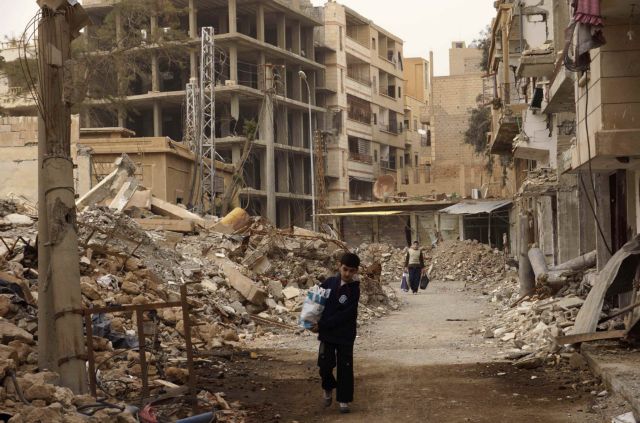The civil war in Syria could be the straw that breaks the camel’s back in the Middle East and lead to the redrawing of border lines, according to high-ranking executives of European and American think tanks. This opinion is shared by officials of countries with an increased presence in the area, who also predict that the world created in the aftermath of the Ottoman Empire’s fall in the 1920s will gave way to a new reality. Top analyst Robert Kaplan believes that this reality is not defined by the “nation state”, but rather resembles the situation during medieval times. National, religious and tribal parameters, such as the Sunnite-Shiite clashes, are coming to the forefront, blurring border lines.
The new map of the Middle East, which resembles the Sykes-Picot Agreement of 1916, according to which London and Paris split areas of the former Ottoman Empire into areas of influence, will not come out of thin air. It is obvious that everyone is preparing. According to Robin Wright, who spoke to the Sunday edition of To Vima, this process could take some time, “a decade or two”.
Wright, who is an analyst at the United States Institute of Peace (USIP) and the Wilson Center, eloquently described what this “new map of the Middle East” would look like in an extensive article in the New York Times. The analyst explains that for the first time in two centuries the region will determine its own fate, rather than being determined by foreign forces. Wright believes that this will happen in many ways, rather than a singular event such as war.
The “new Syria”
When the State Department spokesman claimed that Bashar al Assad would never rule “all of Syria” again a few months ago, few paid attention to detail. Syria however is slowly starting to see its borders change. As Washington and Moscow are negotiating behind the scenes for a mid-November international convention in Geneva, Syria is essentially split into three.
According to Mrs. Wright, there is one strip of land that runs parallel to the Mediterranean coast that starts from the south, goes by Damascus, Homs and ends in the North, at the border with Lebanon. The Alewites and Assad’s regime dominate in this region. The biggest part of the formerly united Syria is dominated by Sunnite rebels, who are split into many groups and at present groups related to Al Qaeda are the key players (such as Al Nusra, which the Americans have dubbed a terrorist organization).
Perhaps the most interesting development involves Kurds in Syria. That is because Syria is neighboring two other nations with significant Kurdish populations, namely Iraq and Turkey. Diplomatic circles from Washington have explained to To Vima that the Kurdish factor has been critical to American plans from the start.
Many envision the establishment of a “Kurdish corridor” that would include Iraqi Kurdistan, Kurds from Syria and (why not?) Kurds from Turkey. In the future this corridor could allow the Mediterranean access to the sources of energy in the Middle East, as a safer option to the Persian Gulf.
The leader of Iraqi Kurds Massoud Barzani is in extensive talks with the Americans. According to various sources, he has visiting Washington numerous times after the outbreak of the Syrian crisis. Barzani tried to appeal to the Kurds in Syria, but was unsuccessful. Instead, the Party for Democratic Union (PYD) of Syrian Kurds opted to operate with greater autonomy, without necessarily burning bridges with Barzani. When the borders between Syrian and Iraq opened last August, about 50,000 Syrian Kurds fled to Iraq.
Barzani’s plans for a “pan-Kurdish conference” with the participation of about 600 members of 40 Kurdish groups from Iraq, Syria, Turkey and Iran might have delayed, but it is indicative of his intentions. This has troubled Ankara, which is trying to break this front by appealing to PYD leader Saleh Muslim. Turkey knows that PYD has close relations to PKK. When Muslim visited Turkey for talks he refused to commit to anything. The Recep Tayyip Erdogan initiative to liberalize its policy on Turkish Kurds may also be viewed in a similar light. Unless the demands of Turkish Kurds are not met, even to a small degree, they will continue to exhibit separatist tendencies, looking to expand into Iraq and Syria.
The Iraqi riddle
The 605-kilometer border between Syria and Iraq has ceased to exist. Sunnite warriors, either from Al Nusra or the ISIS, come and go as they please. Steve Blockmans, an analyst with the Center for European Policy Studies in Brussels, notes that the Syrian civil war has reignited a religious conflict that did not die out with the American invasion of Iraq in 2003.
UN correspondent to Iraq Martin Cobbler reported to the Security Council in July that the battlefields of Syria and Iraq are coalescing. The analysts, including Mr. Blockmans, believe that the Sunnite resistance in Syria acts like an example for Sunnites in Iraq who feel oppressed by the Shiite and Kurdish coalition. The fear is that now that the Americans have pulled out, Iraq will split into three parts, just like during the Ottoman Empire – into Mosul (Kurds), Baghdad (Sunnites) and Basra (Shiites), before the British established Iraq in 1921.
Destabilization – Hezbollah and the “balkanization” of the Arab Peninsula
Fro the start of the conflict in Syria it was clear that Lebanon would the weakest link in case of a destabilization. The 1975-1990 civil war has left deep wounds and divisions still run high. The mass influx of about 700,000 Syrian refugees exacerbates the problem, while the Shiite Hezbollah acts as Iran’s long arm in the region and supports the Assad regime in Syria to the fullest extent.
At the same time, the “balkanization” becomes apparent in other states that were touched by the Arab Spring, as well as some that avoided it, such as Saudi Arabia. According to the USIP and Wilson Center analyst Robin Wright, talks with Yemen could lead to the federation splitting into North and South, following a referendum.
In Southern Yemen speak of uniting with Saudi Arabia, thus gaining access to the Arabian Sea. Meanwhile, the Saudi leadership is too old to have an effect on regional developments and the burgeoning corruption, in order to tackle a Shiite minority revolt, especially in the oil-rich areas in the East.
Things are just as bleak in Libya, where hopes ran high after the fall of Gaddafi. Many believe that the conflict in Libya was not so much as a result of the Gaddafi regime’s absolutism, as much as the will of Benghazi to become independent from the center. Mrs. Wright asserts that the people in Tripoli look towards the Maghreb and the Cyrenaica towards the eastern Muslim world. We must not forget that 80% of Libya’s oil reserves are in Cyrenaica. The division could come in three, since the province of South Fezan has a different ethnic composition and is more in line with the African heartland than North Africa.
The fear of a destabilization in the Middle East understandably concerns everyone. The USA, Russia, EU and even China speak of a diplomatic solution in order to avoid a worst case scenario. Nothing will happen quickly though. A proxy war is being fought in Syria between Iran (with the direct support of Hezbollah), Turkey, Saudi Arabia and Qatar. Meanwhile Russia and China maintain a stance that suits Assad, while the USA supports a moderate opposition.
Based on this, Steven Blockmans believes that there can be no viable solution if the old Sykes-Picot Agreement is not buried and a new agreement, including possible border changes, is not composed. One parameter that could be critical in the new round of negotiations could be the Iranian nuclear program. As it appears that both Iran and the USA share the same feelings, it appears that it could act to stabilize the situation in the Middle East and the transition to a new tomorrow.
Angelos Al. Athanasopoulos
– Originally published in the Sunday print edition



